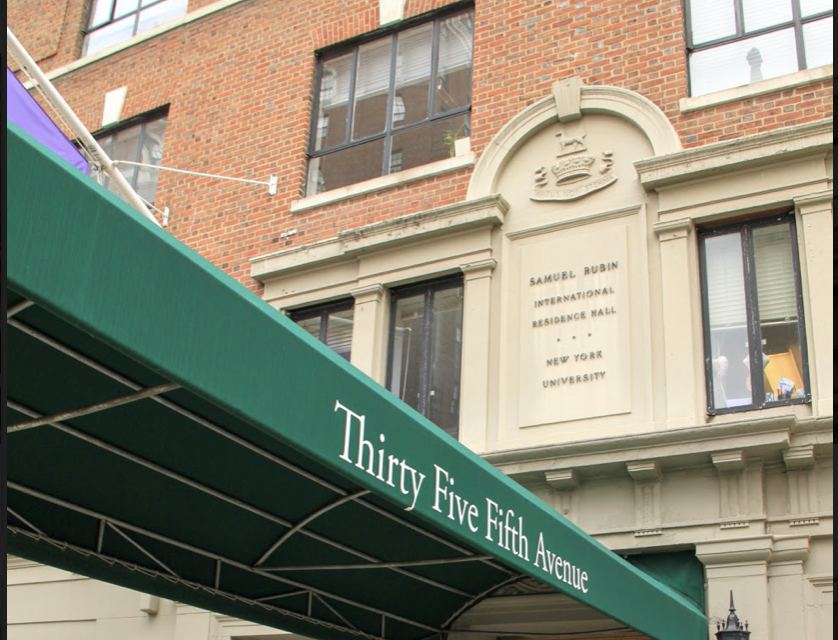Most students living in NYU’s Rubin Residence Hall were cleared to end quarantine on Wednesday night, Sept. 16, at around 8 p.m. The freshman dorm’s residents — all of whom were tested for COVID-19 on Monday, Sept. 14 — received word of their release in an email from Dr. Carlo Ciotoli, Executive Lead of NYU’s COVID-19 Prevention & Response Team.
Rubin residents who’d not yet received Monday’s test results were to continue quarantining until they’d received their results, Ciotoli wrote; residents deemed “close contacts” of infected students must continue isolating for 14 days in total. Students were relieved to be free, but were frustrated by the University’s communication — or lack thereof.
“The stressful part for us was [the University was] like, ‘You are in quarantine till Tuesday, and then we will make further decisions,’” Siegrid Tuttle, a Gallatin first-year, said. “We didn’t know whether we were going to be in quarantine for two weeks or until Tuesday, and they didn’t tell us their plan.”
“It added to the confusion that NYU’s tracking service did not update the cases for a while,” Tuttle continued.
In a Sept. 12 email apprising Rubin residents of their situation and ordering them to immediately quarantine until “at least Tuesday,” Ciotoli wrote that NYU’s ongoing weekly testing program had revealed four cases of COVID-19 within the dorm. On Sept. 14, NYU’s “Summary Update on COVID-19-related Developments” reported that the testing program had discovered six cases within the building. In a Sept. 16 email, Ciotoli wrote that Rubin’s dorm-wide testing had revealed “two additional COVID-19 cases, for a total of eight out of Rubin’s approximately 400 residents.”
On NYU’s “NYC COVID-19 Testing Data” dashboard, the rolling 14-day period was not updated after Sept. 11. When the dashboard was updated on Sept. 17, a new format featured a rolling 7-day period in place of the rolling 14-day period, as well as overall data aggregated since Aug. 1 and a new “14-day block.”
“When we first put up the dashboard, we thought the NYS guidance was based on rolling 14-day periods,” Beckman wrote in an email. “In fact, the State guidance is based on 14-day blocks [e.g. from Aug. 28 to Sept. 11 and from Sept. 12 to Sept. 25]… So keeping a 14-day rolling period on the dashboard seemed confusing and out-of-step with the State guidance.”
Both Tuttle and Evan Kos, a Steinhardt first-year, live in Rubin. When residents received the Sept. 12 email, Tuttle said, “if you were at home, you had to stay home and could not come back to Rubin. If you were anywhere near Rubin, you were just in your room. If you had clothes in the washing machine, you could not touch those. We’re still not sure what happened to the kids who tested positive. I’m not sure if they got removed from the building but I know their roommates had to quarantine in Rubin.”
It was previously reported that Zion Glover, a Stern first-year, was moving into Rubin when he tested positive for COVID-19. After he’d already visited Rubin’s open lounge, he was isolated at NYU’s Second Street Residential Hall.
While quarantining, Kos, a music major, did homework, practiced the trombone and played the videogame Among Us. NYU employees took his trash out and delivered his Grubhub and grocery orders with a knock on the door. He said he’d heard that some of his roommates had issues with Grubhub orders.
“The app would say that it delivered and they gave it to the people in the lobby, but then they never got it in the room,” Kos recalled. “Although they had people to bring us our deliveries, it’s possible that some of those got mixed up. I got all my stuff.”
Tuttle said it’s impossible, when Zooming into in-person classes, to hear students sitting in the last two rows of seats. Kos noted the hassle of maintaining a sleep schedule during quarantine, and Tuttle described the difficulty of maintaining a general rhythm.
“I accidentally missed a class because just my routine and everything kind of got uppended,” Tuttle said. “For one of my classes, we don’t have any kids Zooming in, so we had to email the teacher before and have him set up Zoom. But the teachers reacted pretty well.”
Originally worried about his inability to practice for his keyboard class, Kos described his professor’s reaction as respectful and understanding. He said he received emails from the University about resources, but didn’t recall what kind of resources. Tuttle said she received a text message from the Student Health Center.
“Rubin kids started replying to those texts, because we felt really isolated and were also super bored, and actually realized there are people who monitor those texts,” Tuttle said. “We started talking to the student-success people and that was something people did for a few hours.”
“They didn’t send us mental health resources or anything,” she added.
Kos appreciates NYU’s case-by-case response, understanding the four-day quarantine was necessary so that the University neither ignored the outbreak nor threw the entire dorm into a two-week quarantine. Tuttle is more skeptical.
“I feel like most of these cases can be tracked back to NYU’s decision to allow kids who had had no tests yet on campus for 48 hours,” she said. “Because we had kids in the lounge who later tested positive and NYU had just allowed them to just hang out in the lounge.”
Email Aarushi Sharma and Trace Miller at [email protected].

























































































































































